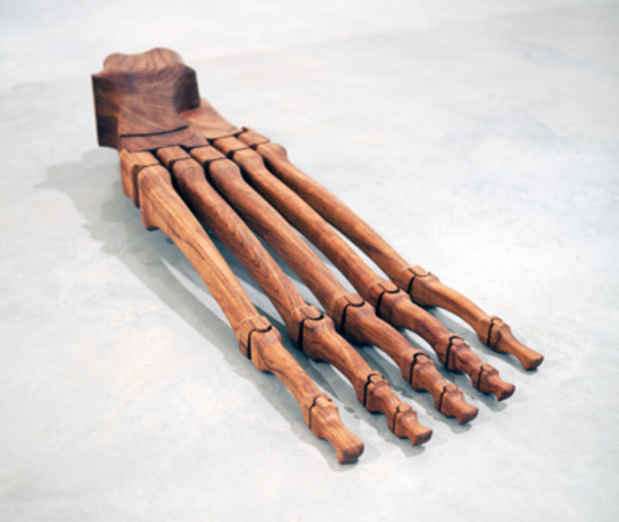"The Third Meaning II" Exhibition
RH Gallery

This event has ended.
The work in the exhibition contains a third order of meaning, beyond the obvious and the symbolic. Coined by Roland Barthes, the term, “The third meaning,” is a representation without a direct, material source -- a “signifier without a signified.” It exists “where another language begins. The third meaning – theoretically locatable but not describable can (now) be seen as the passage from language to significance” (Roland Barthes). The “third meaning” emerges from and with the viewer to bridge the object of art with its sublime qualities: an experience moving us, however uniquely.
Pushing the boundaries of media, several artists defy categorization, working across multiple media. In Paul Edmunds’ recent series Pitch, the artist uses line or edge to explore visual correspondents for music and its constituent parts resulting in intricate abstractions in sculpture and drawing. Bordering on sculpture, Kirstine Roepstorff’s collages juxtapose photographic, archival and abstract elements on multi-layered surfaces. Parastou Forouhar’s recent digital drawings and bean bag chairs reflect recurrent themes that straddle the lines between ornament and confinement as well as beauty and terror. Daniel Escobar explores issues of representation and perception within the urban space. In his series Permeable (Up Close), the artist extracts details from billboard
advertisements, erasing their context in the process, and transforming the images into unique composites. Soledad Arias’ work explores the slippage of meanings in the aesthetic and literary reading of texts. Using text as her primary medium, Arias produces works in video, neon, installation and print. Ken Nicol also uses text as his primary medium albeit in a different form. His labyrinthine drawings camouflage phrases like “fuck off” as geometric abstractions.
Grounded in the context of tradition and history, several artists expose a “third meaning” through painting. Wolfgang Ellenrieder uses a variety of sources including diverse archives, stock photography as well as his own photography, collage and architectural models. His studio resembles a laboratory as Ellenrieder makes his own paint from raw pigments and assembles his sources as references to produce simultaneously figurative and abstract compositions.
Dante Horoiwa’s imagery, founded within a deeply personal narrative, is influenced by Brazilian urban art and his Japanese heritage. Inspired by comic book art, Atsushi Fukui similarly employs a personal language to depict fantastical imaginary scenes. Hideaki Kawashima has built a population of haunting characters influenced by his mentor Yoshitomo Nara. Their spiritual presence evolved through an important two year period in which the artist was a practicing monk. Micah Ganske employs a painstaking technique painting diluted acrylic on muslin rendering his brushstrokes invisible even as they delineate the tiniest details of a bird’s eye view of abandoned cities blanketed by shadows of industrial machinery.
Several artists push similarly complex narratives and processes into the three dimensional realm of sculpture. Shao Fan’s work epitomizes the bridge between past and present employing the traditions of ancient Chinese periods, such as Ming Dynasty wood construction, with contemporary subjects and materials. Young Sook Park's ceramic works, inspired by the “lost” art of the Chosun dynasty, fuse ancient Korean artistic traditions with a contemporary sensibility. John O’Reilly experiments with resin and various powdered materials such as bone, porcelain or graphite to produce sculptures reminiscent of altar pieces in the form of animals. Yi Zhou’s work begins with her primary medium of 3-D animated video. Zhou then produces physical sculptures which create a
tension between the imaginary world of the video and real space.
Bridging sculpture with design, Fredrik Färg and Katrina Vonnegut’s innovative work is functional art. Inspired by the spirit of primates and hominids, Färg mirrors the process of evolution in a series of baked leather stools and cabinets titled Succession. Vonnegut integrates traditional processes such as knitting with minimalist forms in natural woods, producing functional furniture containing a tension between handmade and mechanical processes.
The opening reception will feature a performance program with Tamar Ettun, Jaeeun Lee and Netta Yerushalmy. Ettun will present What We Have In Our Pockets, a participatory performance and reading revolving around a story of the same name by Etgar Keret. Lee will present The Raker and the Cactus, inspired by George Bataille’s essay The Labyrinth in which a comparative discussion on conventional architecture and the labyrinth critiques the repression inherent in social order. Yerushalmy presents Self Portrait – Sketch #3 in which the artist creates a self-portrait in movement inspired by the raw and innocent expression of the artist as a child.
Media
Schedule
from June 26, 2012 to September 06, 2012
Opening Reception on 2012-06-26 from 18:00 to 20:00